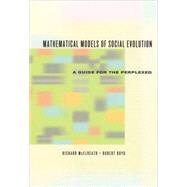
Note: Supplemental materials are not guaranteed with Rental or Used book purchases.
Purchase Benefits
Looking to rent a book? Rent Mathematical Models of Social Evolution [ISBN: 9780226558264] for the semester, quarter, and short term or search our site for other textbooks by McElreath, Richard. Renting a textbook can save you up to 90% from the cost of buying.
| Preface | p. ix |
| Theoretician's Laboratory | p. 1 |
| The structure of evolutionary theory | p. 3 |
| The utility of simple models | p. 4 |
| Why not just simulate? | p. 8 |
| A model of viability selection | p. 11 |
| Determining long-term consequences | p. 16 |
| Nongenetic replication | p. 27 |
| Animal Conflict | p. 37 |
| The Hawk-Dove game | p. 38 |
| Retaliation | p. 46 |
| Continuous stable strategies | p. 52 |
| Ownership, an asymmetry | p. 55 |
| Resource holding power | p. 58 |
| Sequential play | p. 60 |
| Altruism & Inclusive Fitness | p. 71 |
| The prisoner's dilemma | p. 72 |
| Positive assortment | p. 76 |
| Common descent and inclusive fitness | p. 78 |
| Rediscovering Hamilton's rule | p. 82 |
| Justifying Hamilton's rule | p. 97 |
| Using Hamilton's rule | p. 99 |
| Reciprocity | p. 123 |
| The Axelrod-Hamilton model | p. 124 |
| Mutants and mistakes | p. 132 |
| Partner choice | p. 145 |
| Indirect reciprocity | p. 150 |
| Reciprocity and collective action | p. 156 |
| Animal Communication | p. 173 |
| Costly signaling theory | p. 174 |
| Cheap, honest signals | p. 192 |
| Signaling and altruism | p. 201 |
| Social learning | p. 206 |
| Selection among Groups | p. 223 |
| Three views of selection | p. 225 |
| Deriving the Price equation | p. 228 |
| Selection within and between groups | p. 232 |
| Dispersal | p. 249 |
| Sex Allocation | p. 261 |
| Fisher's theory of sex allocation | p. 262 |
| Reproductive value and Fisherian sex ratios | p. 263 |
| Using the Shaw-Mohler theorem | p. 267 |
| Biased sex ratios | p. 271 |
| Breaking the eigen barrier | p. 281 |
| Sexual Selection | p. 295 |
| Quantitative genetic models | p. 298 |
| Fisher's runaway process | p. 305 |
| Costly choice and sensory bias | p. 309 |
| Good genes and sexy sons | p. 313 |
| Appendixes | p. 333 |
| Facts about Derivatives | p. 333 |
| Facts about Random Variables | p. 335 |
| Calculating Binomial Expectations | p. 337 |
| Numerical Solution of the Kokko et al. Model | p. 343 |
| Solutions to Problems | p. 349 |
| Bibliography | p. 393 |
| Index | p. 409 |
| Table of Contents provided by Ingram. All Rights Reserved. |
The New copy of this book will include any supplemental materials advertised. Please check the title of the book to determine if it should include any access cards, study guides, lab manuals, CDs, etc.
The Used, Rental and eBook copies of this book are not guaranteed to include any supplemental materials. Typically, only the book itself is included. This is true even if the title states it includes any access cards, study guides, lab manuals, CDs, etc.